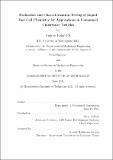Evaluation and Characterization Testing of Liquid Fuel Cell Chemistry for Applications in Unmanned Underwater Vehicles
Author(s)
Roley, Andrew
DownloadThesis PDF (2.049Mb)
Advisor
Gallant, Betar
Terms of use
Metadata
Show full item recordAbstract
Previous Unmanned Undersea Vehicle (UUV) powering has focused primarily on improved efficiency and energy density. However, these gains are often offset by the need for additional buoyant volume, and drag penalties associated with this larger volume. While fuel cells have been proposed and implemented for both manned and unmanned undersea vehicles, they often rely on compressed and/or cooled liquid 𝐻₂ and 𝑂₂, with bulky containment structures either within or outside a pressure hull.
Massachusetts Institute of Technology (MIT) Lincoln Laboratory (LL) has identified Liquid Fuel Cells (LFCs) (specifically Liquid-to-Liquid) as an especially beneficial energy source for UUVs. Literature examples exist which demonstrate LFC viability, although there is presently little to be found regarding applications to UUVs. Additionally, LFCs often make use of Gas Diffusion Layers (GDLs), despite the lack of gaseous species present on either the oxidation side, reduction side, or both. This thesis seeks to investigate potential fuel cell improvements by eliminating GDLs from a Membrane Electrode Assembly (MEA), and to identify the best candidates for a near-neutrally-buoyant fuel cell.
Date issued
2021-06Department
Massachusetts Institute of Technology. Department of Mechanical EngineeringPublisher
Massachusetts Institute of Technology